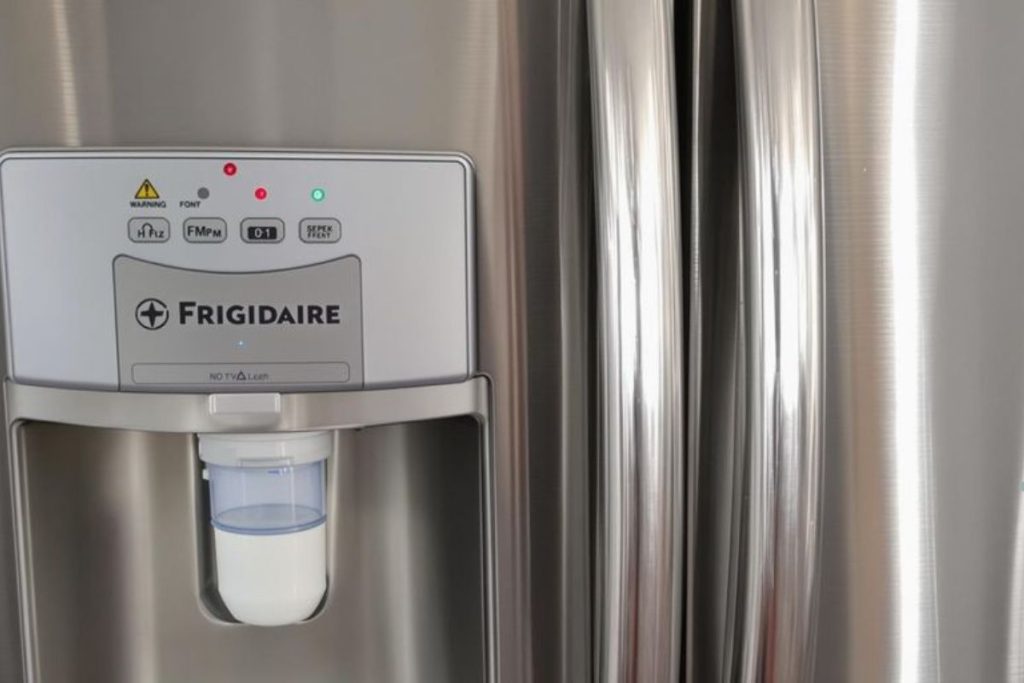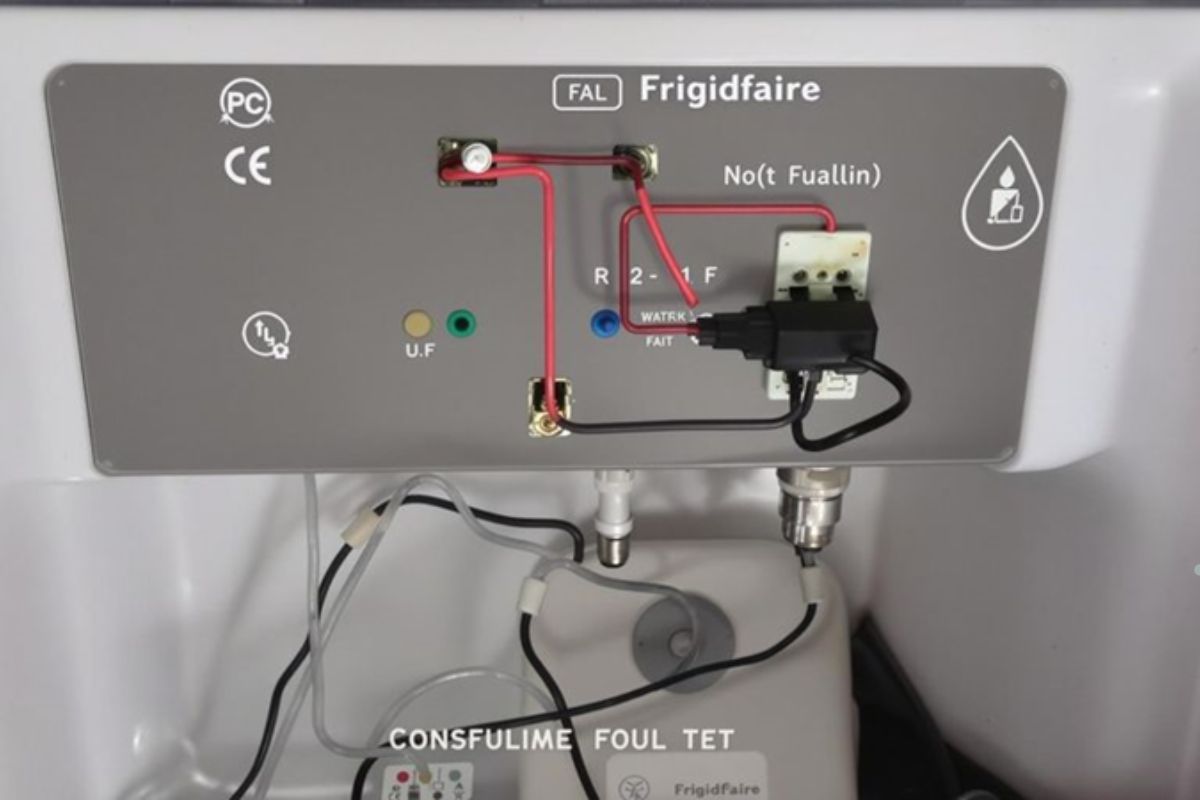
If your Frigidaire refrigerator dispenser is acting up, you’re not alone. It can be super frustrating when you just want some ice or water, and the dispenser refuses to cooperate. The good news? Most of the time, the issue can be fixed without too much hassle. In this guide, we’ll go over some common problems and how to troubleshoot them. Whether it’s an electrical problem, a clogged filter, or something else, we’ve got you covered.
Key Takeaways
- Start by checking the basics, like power and water supply, before diving into complicated fixes.
- A clogged water filter or frozen lines are common reasons for water flow problems.
- Electrical issues, like a faulty switch or wiring, can stop the dispenser from working.
- Ice jams in the chute or a broken auger motor often cause ice dispenser issues.
- If you’re unsure or the problem persists, calling a professional might save you time and stress.
Common Reasons for a Non-Functional Frigidaire Refrigerator Dispenser
Power Supply Issues and How to Fix Them
If your dispenser isn’t working, the first thing to check is the power supply. A disconnected or faulty power source can completely disable the dispenser. Start by ensuring the refrigerator is plugged in securely and the outlet is functioning. You can test the outlet by plugging in another device. If the outlet works, inspect the refrigerator’s power cord for any visible damage. Replace it if necessary.
Inspecting the Water Supply Line for Blockages
A clogged or frozen water line can also stop the dispenser from working. The water line runs from the filter to the dispenser, and any obstruction can disrupt the flow. To troubleshoot:
- Turn off the water supply to the refrigerator.
- Disconnect the water line and check for visible blockages.
- Flush the line with warm water to remove any ice or debris.
Note:A frozen section in the water line is a common culprit. Make sure the refrigerator’s temperature settings aren’t too low to prevent freezing.
Understanding the Role of the Dispenser Control Board
The control board acts as the “brain” of the dispenser. It controls all the electrical components, including the motor and sensors. If the control board malfunctions, the dispenser may stop working entirely. Diagnosing this issue can be tricky, but here are some signs:
- The dispenser lights are flickering or not turning on.
- Buttons on the dispenser panel are unresponsive.
- The motor doesn’t activate when you try to dispense water or ice.
If you suspect a faulty control board, it’s best to consult a technician for repair or replacement. In some cases, replacing the control board is the only solution.
Regular maintenance and prompt attention to minor issues can save you from bigger headaches later. Stay proactive to keep your dispenser running smoothly.
Having trouble with your appliances? We provide fast and reliable repair services to get them working like new. Call us now at for expert assistance and hassle-free repairs!
How to Diagnose Electrical Problems in Your Frigidaire Dispenser

Testing the Dispenser Switch for Faults
The dispenser switch is a small but vital component. If it’s defective, your dispenser won’t work no matter how much you press the lever. To test it:
- Unplug the refrigerator to avoid any electrical hazards.
- Use a screwdriver to access the dispenser assembly.
- With a multimeter, check the continuity of the dispenser switch. If the reading shows no continuity, the switch needs to be replaced.
Checking the Door Switch for Proper Functionality
The door switch controls whether the dispenser operates when the refrigerator door is open or closed. If it’s not working right, the dispenser could remain inactive. Here’s how to inspect it:
- Open the fridge door and locate the switch.
- Press it manually to see if the interior light turns off. If the light stays on, the switch may be faulty.
- Test the switch with a multimeter for continuity. Replace it if needed.
Examining the Wiring Connections
Loose or damaged wiring can cut off power to your dispenser, making it non-functional. Inspecting the wiring is straightforward:
- Disconnect the refrigerator from the power source.
- Look for any frayed or disconnected wires near the dispenser assembly and control board.
- Securely reconnect any loose wires or replace damaged ones to restore functionality.
Electrical issues in your refrigerator dispenser can be tricky, but with a little patience and the right tools, you can often resolve them yourself. Always prioritize safety by turning off the power before you start.
If your Frigidaire refrigerator dispenser isn’t working properly, you’re not alone. It’s frustrating when you need ice or water, and nothing comes out. The good news? Many issues have simple fixes. In this guide, we’ll cover common problems and troubleshooting steps, from electrical issues to clogged filters and more. Also, if your refrigerator has an unpleasant smell, check out our guide on how to remove odors effectively.
Water Flow Problems in Frigidaire Refrigerator Dispensers

Clogged or Frozen Water Filter Troubleshooting
One of the most common reasons for water flow issues is a clogged or frozen water filter. Over time, debris and minerals can build up, restricting the flow of water. If your dispenser isn’t working, start by checking the filter. Remove it and inspect for any visible blockages. If it looks dirty or hasn’t been replaced in over six months, it’s time for a new one. Always ensure you’re using the correct filter type for your Frigidaire model.
Inspecting the Water Inlet Valve for Damage
The water inlet valve controls the flow of water into the dispenser. A damaged or faulty valve can prevent water from reaching the dispenser. To check it, turn off the water supply and disconnect the valve. Look for cracks, wear, or mineral deposits. A malfunctioning valve may also cause inconsistent water flow or leaks. If you suspect the valve is the issue, consider replacing it.
Consistent maintenance of the inlet valve can prevent long-term problems and ensure smooth operation of your refrigerator’s water dispenser.
How to Address Low Water Pressure Issues
Low water pressure from your home supply can also cause troubles. Your dispenser needs at least 20 psi to function properly. To test water pressure, disconnect the water line and use a pressure gauge. If the reading is below the required level, you might need to adjust your home’s water supply settings or consult a plumber. If the pressure is fine and the problem persists, check other components like the water inlet valve or the filter for potential issues.
Ice Dispenser Malfunctions and Their Solutions
Clearing Ice Jams in the Dispenser Chute
Ice jams can happen when ice clumps together and blocks the dispenser chute. This is often due to high humidity or when the ice maker hasn’t been used in a while. To fix this, start by turning off the ice maker. Then, carefully remove any visible chunks of ice from the chute using a plastic utensil to avoid causing damage.
If the jam is deeper, you might need to remove the ice bin and let it thaw. Always check for any signs of frost buildup, as this could indicate a problem with the freezer’s temperature settings.
Explore our services for expert appliance repair and maintenance solutions. From refrigerators to ovens, we provide reliable service to keep your appliances running smoothly.
Testing the Ice Maker Assembly
The ice maker assembly is essentially the heart of your ice dispenser. If it’s not working, you won’t get ice, plain and simple. To test it, start by ensuring the ice maker is turned on (sounds obvious, but it happens). Next, inspect the ice mold for any stuck ice. If there’s no ice at all, it could be a sign the water supply is blocked or the assembly itself is faulty.
If you’re handy with tools, you can use a multimeter to check for electrical continuity in the ice maker’s components. If the readings are off, it might be time to replace the assembly. Otherwise, consider calling a technician.
Replacing a Faulty Auger Motor
The auger motor is what pushes ice through the dispenser chute. A broken motor means no ice delivery, even if everything else is working fine. To check it, listen for a humming sound when you activate the dispenser. No sound? That’s a red flag.
Before replacing the motor, confirm it’s the issue by inspecting the wiring and ensuring there’s no ice clogging the mechanism. If you’re certain the motor is bad, you’ll need to order a replacement specific to your refrigerator model. Replacing it can be tricky, so if you’re not confident, it might be best to get professional help.
Regular maintenance, like cleaning the ice bin and checking for wear, can prevent many common ice dispenser issues. Don’t wait until it stops working to give it some attention.
For issues like wear and tear on the ice dispenser drum, common problems include ice jams and damage from regular use. Inspecting and addressing these early can save you from bigger headaches down the line.
Understanding Sensor and Control Board Failures
How to Identify a Malfunctioning Control Board
The control board is like the brain of your Frigidaire refrigerator dispenser. When it stops working, you might notice the dispenser not responding at all or behaving erratically. Common symptoms include no water flow, ice not dispensing, or lights flickering on the control panel. To figure out if the control board is to blame:
- Check for visible damage, like burn marks or melted components.
- Test the board using a multimeter to see if it’s sending the correct signals.
- Ensure the wire harness connectors are secure; if damaged, they must be replaced. This is crucial for the proper functioning of the Frigidaire refrigerator’s control panel.
Testing the Dispenser Sensors for Accuracy
The sensors in your dispenser help it know when to dispense water or ice. If these sensors are off, the dispenser might stop working or dispense at the wrong times. To test:
- Use a multimeter to measure the sensor’s electrical output.
- Clean the sensor area to ensure no dirt or ice buildup is interfering.
- Replace the sensor if it shows no activity during testing.
When to Replace the Main Control Board
Sometimes, repairs just won’t cut it, and the control board needs a full replacement. Signs it’s time for a new one include:
- Repeated failures even after resetting the refrigerator.
- Multiple components, like the ice maker and water dispenser, not working simultaneously.
- Visible physical damage to the board.
If you’ve tried troubleshooting and still face issues, replacing the main control board might be your best option. It can feel daunting, but it’s often more cost-effective than continuous repairs.
Preventative Maintenance Tips for Frigidaire Dispensers
Regular Cleaning to Avoid Build-Up
Over time, grime, mold, and debris can accumulate in and around your refrigerator’s dispenser, affecting its performance. To keep things running smoothly, wipe down the dispenser area weekly with a soft cloth and mild soap. Don’t forget to clean the drip tray and nozzle to prevent clogs or unsightly stains. A clean dispenser not only works better but also ensures your water and ice stay hygienic.
Replacing Filters on Schedule
Replacing your water filter isn’t just a suggestion—it’s a must. Filters that are overdue can clog, reduce water flow, and even affect the taste of your water. Make it a point to replace the filter every six months. Ensure the water filter is correctly installed every six months to maintain proper water flow and avoid unnecessary issues with your dispenser or ice maker.
Inspecting Components for Wear and Tear
A quick check of your dispenser’s components can save you from bigger headaches later. Look for cracks, loose parts, or signs of wear, especially on the nozzle, buttons, and any moving parts. If something seems off, address it before it turns into a larger problem. Keeping an eye on these small details can extend the life of your dispenser.
Regular maintenance isn’t just about fixing problems—it’s about preventing them in the first place. A little effort now can save you from costly repairs down the road.
Got a broken appliance? Don’t let it disrupt your day! Our expert repair services can get it running smoothly again. Call us now at for fast, reliable appliance repair you can trust!
When to Call a Professional for Dispenser Repairs
Signs That DIY Repairs May Not Be Enough
Sometimes, even with your best efforts, a problem with your refrigerator dispenser might be beyond what you can handle at home. Here are a few signs that it’s time to bring in a pro:
- Persistent issues: If the dispenser still doesn’t work after you’ve checked the basics like power, water supply, and filters.
- Unusual noises: Grinding, buzzing, or clicking sounds coming from the dispenser that you can’t identify.
- Visible damage: Cracks, leaks, or broken components that require specialized tools or parts to fix.
When you notice these signs, it’s better to avoid making things worse by continuing to tinker with it.
How to Choose a Qualified Technician
Finding the right technician doesn’t have to be overwhelming. Here’s a quick checklist to help you:
- Check credentials: Make sure they’re certified to work on Frigidaire appliances.
- Read reviews: Look for feedback from other customers to gauge their reliability.
- Ask about warranties: A good technician should stand by their work with a service guarantee.
It might also help to ask friends or family for recommendations—they might know someone trustworthy.
Understanding Repair Costs and Warranty Coverage
Repairs can add up, so it’s important to have a sense of what you’re getting into. Here’s a rough breakdown of what to expect:
| Repair Type | Estimated Cost Range |
| Dispenser Switch Repair | $50 – $150 |
| Control Board Replacement | $200 – $400 |
| Water Inlet Valve Repair | $75 – $200 |
Tip: Always check your refrigerator’s warranty before scheduling a repair. Some issues might still be covered, saving you money.
Calling a professional doesn’t mean you’ve failed—it just means you’re making sure the job gets done right. Plus, it’ll save you time and potentially bigger headaches down the road.
Wrapping It Up
So, there you have it. If your Frigidaire refrigerator dispenser isn’t working, it could be something as simple as the lock button being on or as tricky as a clogged water line. The key is to take it step by step and not rush. Start with the easy stuff—check the power, water supply, and settings. If that doesn’t do the trick, you might need to dig a little deeper, like inspecting the filter or the dispenser mechanics. And hey, if it gets too frustrating, calling a professional isn’t the end of the world. Sometimes, it’s just better to let someone else handle it. Hopefully, this guide helped you figure out what’s going on and got your dispenser back in action!
Frequently Asked Questions
Why isn’t my Frigidaire refrigerator dispensing water or ice?
There could be a few reasons. Check if the water supply line is clogged, the water filter is dirty, or the dispenser control board isn’t working.
How do I know if the water filter needs replacing?
If the water flow slows down or tastes different, it’s likely time to change the filter. Most filters need to be replaced every six months.
What should I do if my ice dispenser is jammed?
Start by checking the chute for any stuck ice. Clear it out gently and make sure the ice maker isn’t overfilled.
Can I fix a broken dispenser switch on my own?
If you’re comfortable with tools, you can test and replace the switch. However, if you’re unsure, it’s best to call a professional.
What causes low water pressure in the dispenser?
Low pressure can be due to a kinked water line, a clogged filter, or issues with the water inlet valve.
When should I call a technician for dispenser problems?
If you’ve tried basic fixes and the dispenser still doesn’t work, or if you suspect electrical issues, it’s time to get professional help.
Having trouble with your Frigidaire refrigerator dispenser? Our troubleshooting guide can help you fix common issues quickly. Need professional assistance? Contact us today for expert repair services and get your fridge working smoothly again!
